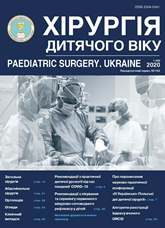Clinical case of volvulus, caused by magnetic beads in digestive tract in 6 year-old child
DOI:
https://doi.org/10.15574/PS.2020.66.92Keywords:
foreign bodies, magnetic beads, digestive tract, children, clinical caseAbstract
Often enough, children swallow foreign bodies (coins, needls, buttons, batteries etc), most of which pass asymptomatically through the digestive tract without causing negative health outcome, but sometimes they can pose a significant health risk to the child. Magnetic objects are considered dangerous because injested multiple magnets can localize in different parts of the digestive tract and attract to each other, which can cause serious complications – ischemia and necrosis of the gut, volvulus, intestinal obstruction, perforation, fistula formation and even mortality.Case report. The article presents a clinical case of treatment 6 year-old child, who was hospitalized to the I surgical department of CNE of Lviv Regional Concil Lviv Regional Children’s Clinical Hospital «OHMATDYT» with a clinical picture of intestinal obstruction. During surgery, volvulus and multiple perforations of small intestine were diagnosed, which were caused by prolonged stay of several magnetic beads in the digestive tract.
Conclusions. We consider it necessary to show that neglect of such property of magnetic objects, such as magnetism, can lead to life-threatening complications. Timely admission and early surgery, when endoscopic removal of the magnets is impossible, can prevent the negative consequences. We consider it necessary to show that neglect of such property of magnetic objects as magnetism can lead to complications.
The research was carried out in accordance with the principles of the Helsinki Declaration. The study protocol was approved by the Local Ethics Committee of all participating institutions. The informed consent of the child’s parents was obtained from the studies.
No conflict of interest was declared by the authors.
References
Alfonzo MJ, Baum CR. (2016). Magnetic foreign body ingestions. Pediatr Emerg Care.32: 698–702. https://doi.org/10.1097/PEC.0000000000000927; PMid:27749667
Anna Lin, Lawrence Chi Ngong Chan, Kam Lun Ellis Hon et al. (2019). Magnetic Foreign Body Ingestion in Children: The Attractive Hazards Case Reports in Pediatrics. 2019. Article ID 3549242: 4. https://doi.org/10.1155/2019/3549242; PMid:31183238 PMCid:PMC6512031
Chung JH, Kim JS, Song YT. (2003). Small bowel complication caused by magnetic foreign body ingestion of children: two case reports. Pediatr Surg. 38: 1545–155. https://doi.org/10.1016/S0022-3468(03)00514-1
Hernandez Anselmi E, Gutierrez San Roman C, Barrios Fontoba JE, Ayuso Gonzalez L et al. (2007, Mar). Intestinal perforation caused by magnetic toys. J Pediatr Surg.42 (3): E13–6. https://doi.org/10.1016/j.jpedsurg.2006.12.066; PMid:17336176
Kay M, Wyllie R. (2005). Pediatric foreign bodies and their management. Curr Gastroenterol Rep.7: 212–218. https://doi.org/10.1007/s11894-005-0037-6; PMid:15913481
Si X, Du B, Huang L. (2016). Multiple magnetic foreign bodies causing severe digestive tract injuries in a child. Case Reports in Gastroenterology. 10;3: 720–727. https://doi.org/10.1159/000450538; PMid:28100992 PMCid:PMC5216246
Zhang YB, Gao ZG, Xiong QX et al. (2017). Clinical experience in the treatment of children who swallowed multiple magnetic foreign bodies: a report of five cases. World J Pediatr.13: 274–277. https://doi.org/10.1007/s12519-016-0083-1; PMid:28101775
Downloads
Published
Issue
Section
License
The policy of the Journal “PAEDIATRIC SURGERY. UKRAINE” is compatible with the vast majority of funders' of open access and self-archiving policies. The journal provides immediate open access route being convinced that everyone – not only scientists - can benefit from research results, and publishes articles exclusively under open access distribution, with a Creative Commons Attribution-Noncommercial 4.0 international license(СС BY-NC).
Authors transfer the copyright to the Journal “PAEDIATRIC SURGERY.UKRAINE” when the manuscript is accepted for publication. Authors declare that this manuscript has not been published nor is under simultaneous consideration for publication elsewhere. After publication, the articles become freely available on-line to the public.
Readers have the right to use, distribute, and reproduce articles in any medium, provided the articles and the journal are properly cited.
The use of published materials for commercial purposes is strongly prohibited.

